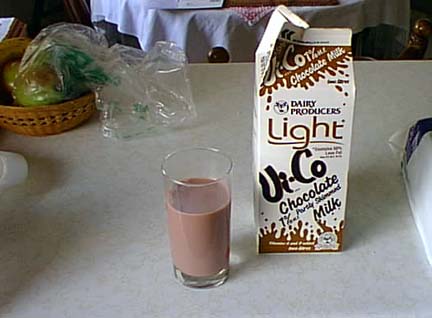Vi-Co - A Milk By Any Other Name
FTLComm - Tisdale
April 30, 1999
For most people chocolate milk in the dairy section of food stores is as basic as
butter and cheese but that just isn't the case. Vi-Co came on the scene in Western
Canada in the early to mid fifties, I am guessing it was 1954 or 55 when I first
tasted what was a very expensive canned beverage. Vi-Co was sold in a brown metal
can that was 6.5 ounces and you had to use a can opener to put a hole in the top.
It was thirty-five cents and at the time a 9 ounce coke was twelve cents, so it
was considered a luxury item. George Moore was the first store in our little village
to have the product and I recall one evening my father and several other men buying
some cans and tasting them around the worn wood counter in Moore's General store.
Sunny (George Moore Junior) was the imposing bartender and I was given a taste.
A few days later I had assembled the necessary investment and went in and bought
my own can of Vi-Co.
As a confirmed chocolate addict I was a frequent customer of George Moore's but it
was a dark and gloomy day when those tiny little cans went up to forty-nine cents.
I can remember the indignation and serious concern had about the serious nature
of inflation. It was about the same time that soft drinks went to fifteen cents
and as I recall my mother started serving us powdered milk fluid milk also had jumped
in price. That's when we started getting our milk from Mr. Johnson, a local farmer.
Initially Vi-Co was an American brand name and was being imported, but a couple of years after its introduction onto the market, Co-op Dairies purchased the name and began selling Vi-Co in the grocery stores. I recall seeing it sold in round paper containers and glass pint returnable bottles. I was amazed to see a full quart bottle of it. It was about that time that Co-op dairies introduced the high shouldered glass milk bottle that was more square in shape then the familiar round glass milk bottle. It seems funny now even to recall it, but there was considerable buyer resistance to wax coated paper milk cartons. I remember George McClement, manager of the Co-op store shaking his head and wondering what the world was coming to with the disappearance of real milk bottles. People felt the milk tasted difference in the paper cartons and my dad was most put off when a large lump of wax landed on his corn flakes one morning.
The evolution of dairy products was not a smooth performance because it was quite a major change to pasteurised milk but homogenised milk was revolutionary. It tasted difference and there was no cream to skim off. The introduction of 2% then 1% is a very recent event and now you can not find whole milk as such, on the dairy shelf as it is now labelled as 3%. One of the most interesting dairy products was UHT (ultra high temperature) milk that was sold off a non-refrigerated shelf beginning in late 1979. This odd tasting milk was a real break through as it had an extended shelf life and was fully nutritional, however it is rare to see it in stores today.
I was amazed recently to see strawberry, banana and other less memorable flavoured milks in convenience stories and now the old and familiar Vi-Co competes with a whole range of other chocolate milks, some of which claim to be milk shakes and some carry candy bar name brands. Over the years a whole system of legends have grown up around chocolate milk, everything from affecting children's teeth to causing hyperactivity and worse. All of these are foolishness because milk is the main component and though we all assume milk is the perfect food it is a great source of calcium and vitamin D but a surprisingly large number of people do not have, or lose the enzyme necessary for the digestion of milk products. The trendy thing to describe this situation is "lactose intollerant". Among North American aboriginal people, as many as one in five have a difficult time getting the nutrition from cows milk.
